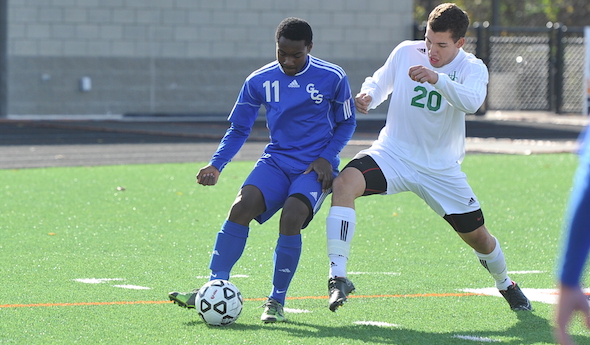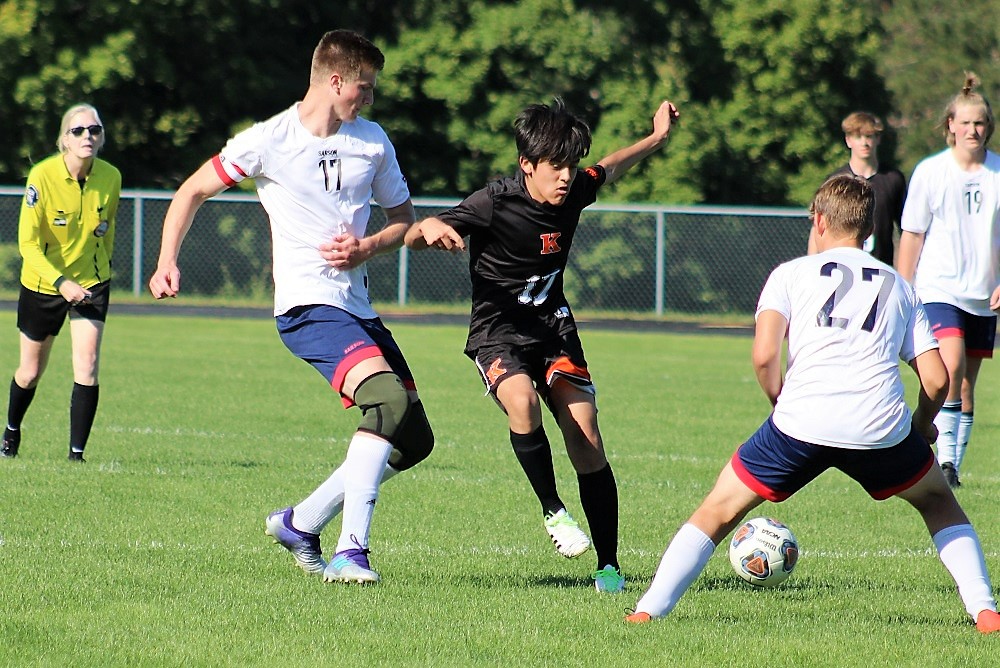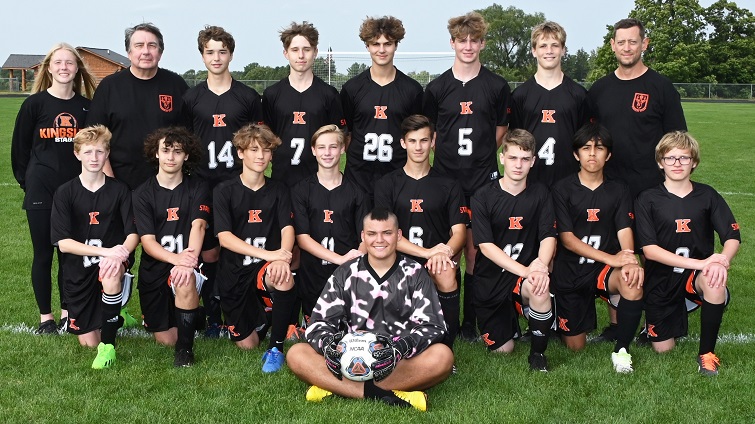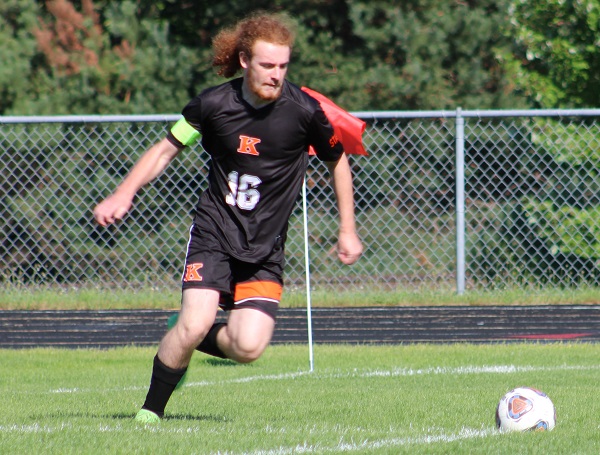
Preview: Perfect Time to Peak
November 4, 2016
By Geoff Kimmerly
Second Half editor
Four of eight finalists at Saturday's MHSAA Boys Soccer Finals are playing to take home the champion's trophy for the first time in their programs' histories.
And considering that none of seven teams that play in leagues won them this fall, claiming the highest title will be even more special.
Burton Genesee Christian is the reigning Division 4 champion and does not play in a league. The other seven finalists finished anywhere from second to fourth in their respective conferences, preparing to peak at the most opportune time and then making the most of the last three weeks.
Saturday's Finals kick off at noon and 3 p.m., with Division 4 followed by Division 1 at Rochester Hills Stoney Creek and Division 3 followed by Division 2 at Comstock Park. All will be broadcast live with subscription on MHSAA.tv, with audio available on MHSAANetwork.com. See below for glances at all eight finalists, and come back to Second Half later Saturday for coverage of all four championship games.
DIVISION 1
EAST KENTWOOD
Record/rank: 15-3-5, No. 19
Coach: John Conlon, 17th season (308-52-37)
League finish: Third in Ottawa-Kent Conference Red
Championship history: Four Division 1 titles (most recent 2012).
Players to watch: Haris Dzafic, jr. GK (0.50 goals-against average, 13 shutouts); Adis Guric, jr. F (10 goals, 9 assists); Narcis Sprecic, sr. F (11 goals, 7 assists).
Outlook: East Kentwood has risen from three seasons without District titles to make its fifth Division 1 Final over the last decade – and in grand fashion, eliminating among others No. 4 Rockford, No. 20 Grand Rapids Forest Hills Central, No. 16 Traverse City West and No. 14 Novi on the way. The Falcons have won 12 of their last 13, and 10 by shutout during that run, while avenging two losses to Rockford by beating the Rams 1-0 in the District Final. Junior forward Adrian Diaz had 11 goals as well entering the week, and senior midfielder Jeo Garcia had nine goals and eight assists.
TROY ATHENS
Record/rank: 19-4-2, No. 6
Coach: Todd Heugh, sixth season (96-21-16)
League finish: Third in Oakland Activities Association Red
Championship history: Four MHSAA titles (most recent 1997), one runner-up finish.
Players to watch: Mason Maziasz, sr. GK (0.53 goals-against average, 15 shutouts); Shamik Patel, sr. M (8 goals, 10 assists); Sami Sami, jr. F (12 goals, 4 assists).
Outlook: Athens is making its deepest run under Heugh, who played on the 1989 Class A championship team and led Rochester to the Division 1 title in 2002 while boys coach at that school from 2000-05. The Redhawks entered the postseason with two straight losses but have outscored six playoff opponents by a combined 18-4 – and avenged an earlier loss to Rochester with a 2-1 Semifinal win. Junior forward Cole Valentine adds another scoring option up front, entering this week with nine goals and four assists.
DIVISION 2
DEARBORN DIVINE CHILD
Record/rank: 12-7-4, unranked
Coach: Dean Kowalski, second season (27-15-5)
League finish: Fourth in Detroit Catholic League AA
Championship history: Has never played in an MHSAA Final.
Players to watch: Shane Ciucci, sr. F (9 goals, 9 assists); Justin Stack, sr. M (8 goals, 5 assists); Evan Mazurek, jr. GK (1.25 goals-against average, 8 shutouts).
Outlook: Divine Child was riding an 0-4-2 stretch into this postseason, but stormed back to make the Finals for the first time with five shutouts in six games, including 2-0 over No. 13 Dexter in the Regional Semifinal. Ciucci earned an all-state honorable mention as a junior and is one of 11 seniors including eight who start. Seven players had scored at least three goals heading into this week, including also seniors Alex Higgins (seven) and Noah Cieglo (six). Kowalski took over the program last season after a decade as an assistant.
MATTAWAN
Record/rank: 21-4-2, No. 11
Coach: Kirt Brown, 11th season (149-75-23)
League finish: Third in Southwest Michigan Athletic Conference
Championship history: Has never played in an MHSAA Final.
Players to watch: Jarrett Hageman, soph. F (27 goals, 5 assists); Evan Marquess, jr. F (5 goals, 11 assists); Casey Kirkbride, sr. GK (0.68 goals-against average, 12 shutouts).
Outlook: Mattawan made the Semifinals last season but graduated 11 seniors from that team, and yet has taken the next step for the first time. The Wildcats also have won at least 20 games for the second straight season under Brown, despite playing in a league including Division 1 No. 2 Portage Northern and No. 18 Portage Central – and suffering three of their four losses this fall to those two teams. Mattawan has won eight straight, a streak that started with a 1-0 win over No. 7 Coldwater and during the tournament has included shutouts of No. 16 Stevensville Lakeshore, No. 8 Holland and No. 1 East Lansing and also a win over No. 12 Marshall.
DIVISION 3
FLINT POWERS CATHOLIC
Record/rank: 17-3-3, No. 4
Coach: Tony Rowe, fifth season (81-23-10)
League finish: Second in Saginaw Valley League
Championship history: Two MHSAA titles (most recent 2013).
Players to watch: Chase Knoblock, sr. F (10 goals, 13 assists); Andrew Simon, jr. M (6 goals, 15 assists); Steven Tuttle, sr. M (12 goals, 11 assists).
Outlook: After leading the Chargers to the Division 3 title in his second season in 2013, alum Tony Rowe has them back in the Final after a run that has included wins over No. 7 Clawson and No. 13 Lansing Catholic. Powers has outscored its six postseason opponents by a combined 27-2 and is on a 14-game unbeaten streak. Knoblock and Simon earned all-state honorable mentions last season but have plenty of scoring help in addition to Tuttle; junior forward Bryan Lendzion led with 17 goals entering this week, and junior midfielder Mason Smith had scored 13.
GRAND RAPIDS CATHOLIC CENTRAL
Record/rank: 20-1-4, No. 1
Coach: Brian Hughes, seventh season (record N/A)
League finish: Second in O-K Blue.
Championship history: Has never played in an MHSAA Final.
Players to watch: Langston Cooper, jr. (12 goals, 4 assists); Fernando Garcia, sr. (21 goals, 12 assists); Alec Winden, jr. (18 goals, 18 assists).
Outlook: Grand Rapids Catholic Central’s first run to an MHSAA Final also has included the first District and Regional titles in program history. The team’s only loss this fall was to Division 2 No. 2 Spring Lake, and the playoff run has included wins over No. 2 Hudsonville Unity Christian, No. 8 Paw Paw and No. 12 Charlevoix. In addition to the high scorers above, senior midfielder Josh Steffes is a key contributor; he made the all-state second team last season.
DIVISION 4
BURTON GENESEE CHRISTIAN
Record/rank: 22-2-1, No. 6
Coach: Doug Anderson, eighth season (131-43-11)
League finish: Does not play in a conference.
Championship history: Division 4 champion 2015.
Players to watch: Cole Russell, sr. M (21 goals, 16 assists); Zach Noecker, sr. GK (0.63 goals-against average, 15 shutouts), Caleb DuPree, sr. F (27 goals, 9 assists).
Outlook: Going back to last season’s perfect run, Genesee Christian won 33 straight games including the first five of this fall, and has now won nine straight while also challenging itself in losses to much larger Fenton and Lake Fenton. The Soldiers haven’t given up a goal in the postseason, outscoring six opponents by a combined 24-0, with the latest shutout over No. 3 Ann Arbor Greenhills. Noecker, Russell and senior midfielder Riley Buchalski (5 goals, 5 assists) made the all-state first team last season, and DuPree made the second team.
MUSKEGON CATHOLIC CENTRAL
Record/rank: 13-8-4, unranked
Coach: Bill Moulatsiotis, sixth season (72-49-7)
League finish: Tied for third in Lakes 8 Conference
Championship history: Division 4 runner-up 2008.
Players to watch: Jose Zambrano, jr. F; Connor O’Neill, sr. GK; Jose Mojica, jr. M. (Statistics not submitted.)
Outlook: Muskegon Catholic Central has been one of the surprises of the tournament, downing No. 4 North Muskegon, No. 9 Grand Rapids Covenant Christian and No. 18 Kalamazoo Hackett after falling to North Muskegon and Covenant Christian during the regular season. But Zambrano was an all-state second-team pick last season and O’Neill and Mojica were honorable mentions, so the upsets can’t be entirely shocking. The Crusaders have won 10 of their last 13 games.
PHOTO: Genesee Christian's Caleb DuPree (left) works to maintain control of the ball during last season's Division 4 Final win over Kalamazoo Hackett.

Records May Not Show It - Yet - But Kingsley Soccer Improving, Ready to Rise
By
Tom Spencer
Special for MHSAA.com
October 21, 2022
Kingsley did not go on unnoticed this fall in Northwest Conference soccer play.
 In fact, many took considerable notice of the Stags.
In fact, many took considerable notice of the Stags.
And, the coaches of the league’s top teams are looking for even bigger things ahead from Kingsley. Quite, frankly, they’re hoping it comes to fruition for their own teams’ sakes.
“It’s always beneficial to have a solid conference – as it helps teams prepare for playoffs,” said Rob Sirrine, coach of this year’s league title winner, Leland. “We expect them to improve in the next few years.
“Kingsley has had a rough go of it the last few years – not unlike other schools in our conference that also have football teams,” he continued. “I think they have some potential based on the coaches they have brought in and volunteers that are helping out the program.”
Second-year Kingsley head coach Tim VanWingerden welcomed Mike Alanson as a volunteer varsity assistant coach and two middle school coaches — Bert Baker and Lars Mitchell — this fall. Baker and Mitchell had kids on the Stags’ middle school squad this season.
League opponents, including the varsity coaches, noted big differences already.
Buckley coach John Vermilya, whose Bears finished second this year after winning the crown a year ago, echoed Sirrine.
“Kingsley has shown incredible resilience over the last three seasons,” Vermilya said. “This season they bounced back with an influx of young players, and you can see their growing tactical awareness along with technical ability.”
Youth soccer is growing in the Kingsley community as well, adding to the excitement. In fact, VanWindergen has two boys —Ted, 10, and Gunnar, 9, playing in the youth program. Tabatha VanWingerden, wife of the Stags’ head coach, is the coach of the U-12 team.
 Mitch Miggenburg, Kingsley’s athletic director, is pleased to see the growth in numbers as the Stags move through “a 3-5 year” plan to become more competitive in soccer and cross country. He’s hoping those sports can find success similar to that of the Stags’ football team.
Mitch Miggenburg, Kingsley’s athletic director, is pleased to see the growth in numbers as the Stags move through “a 3-5 year” plan to become more competitive in soccer and cross country. He’s hoping those sports can find success similar to that of the Stags’ football team.
Kingsley is 6-2 on the gridiron and looking ahead to the football playoffs again. The Stags are fielding a full squad of cross country runners this fall after some lean years.
With an enrollment of well under 500, Kingsley has been able to involve 62 boys in football, 10 in cross country and 17 in soccer. Miggenburg noted cuts had to be made to the school’s co-ed middle school team this fall.
“I think we’re headed in the right direction,” Miggenburg said. “If you look at our record, you might not see it.
“This is not something that is going to happen overnight,” he continued. “In order for us to develop the way we want to develop, we’ve got to put some time in outside the season. And we have some coaches willing to help and do that, and it will only benefit us in the future.”
The Stags have not won a game the last two seasons, but VanWingerden believes success, as defined by wins, is right around the corner. He knows his team has shown moments of brilliance in every contest before the goals mounted against the Stags.
VanWingerden and Kingsley have been praised for outstanding sportsmanship by referees, opposing players and coaches.
Other bright spots in 2022 included outstanding play by freshman goalie Nate Lamie and stellar defense by senior captain Zakkeus Bedford. The Stags will have to overcome the loss of Bedford, their only senior this year, who played with tremendous drive and was the leader on the field.
But, they should return rest of the squad hungry for wins. And, they’ll add some solid incoming freshman players.
 “I think next year is going to be a big turnaround,” VanWingerden predicted. “So the next two, three years, we’re going to start turning some heads.”
“I think next year is going to be a big turnaround,” VanWingerden predicted. “So the next two, three years, we’re going to start turning some heads.”
Despite not experiencing wins either of the last two seasons, the Stags have enjoyed playing soccer.
“There is a camaraderie there with these kids I just can’t quite put my finger on, but it’s part of what binds them better, facing that adversity on a regular basis and getting though it together as a team,” VanWingerden said. “They’ve come to practice the next day determined to work hard and try to improve little by little.
“The common goal to get better pulls them together and gives them a determination that is hard to find.”
Many conference games this year were played 9 vs. 9 or 10 vs. 10 per conference agreement. Benzie Central and Glen Lake played with fewer than 11 players in every contest this season. Benzie Central, Glen Lake, Kingsley and Suttons Bay all compete in cross country, football and soccer. Leland and Buckley do not field football squads.
The Comets won a District championship 1-0 on Thursday at Suttons Bay. The Bears are playing in a District Final on Saturday in Lakeview. Kingsley’s 0-19 season ended with a Division 3 District-opening loss to Boyne City last week.
The Stags have already begun working on next year. Offseason plans include drop-in soccer and participation in a newly-developed strength and conditioning program.
“The program is not going to move forward unless we put in a ton of work,” VanWingerden acknowledged. “We’ve had glimpses into what we could be if we did it on a regular basis.
“It is really encouraging.”
 Tom Spencer is a longtime MHSAA-registered basketball and soccer official, and former softball and baseball official, and he also has coached in the northern Lower Peninsula area. He previously has written for the Saginaw News, Bay County Sports Page and Midland Daily News. He can be reached at [email protected] with story ideas for Manistee, Wexford, Missaukee, Roscommon, Ogemaw, Iosco, Alcona, Oscoda, Crawford, Kalkaska, Grand Traverse, Benzie, Leelanau, Antrim, Otsego, Montmorency, Alpena, Presque Isle, Cheboygan, Charlevoix and Emmet counties.
Tom Spencer is a longtime MHSAA-registered basketball and soccer official, and former softball and baseball official, and he also has coached in the northern Lower Peninsula area. He previously has written for the Saginaw News, Bay County Sports Page and Midland Daily News. He can be reached at [email protected] with story ideas for Manistee, Wexford, Missaukee, Roscommon, Ogemaw, Iosco, Alcona, Oscoda, Crawford, Kalkaska, Grand Traverse, Benzie, Leelanau, Antrim, Otsego, Montmorency, Alpena, Presque Isle, Cheboygan, Charlevoix and Emmet counties.
PHOTOS (Top) Kingsley’s Rolando Torres works to gain possession against Traverse City Bulldogs’ Tyler Ritola (17), Jonathon Scott (27) and Syrus Ritola (19), as Josephine Arrowood officiates. (Middle) This fall’s Kingsley soccer team. (Below) Zakkeus Bedford lines up a kick this season. (Photos courtesy of the Kingsley athletic department.)

